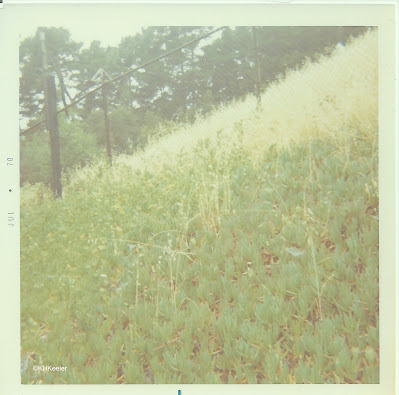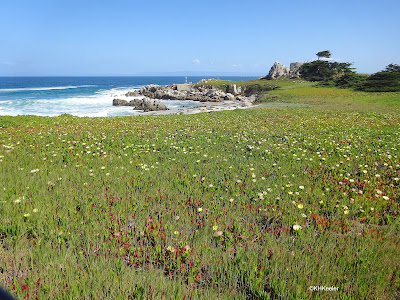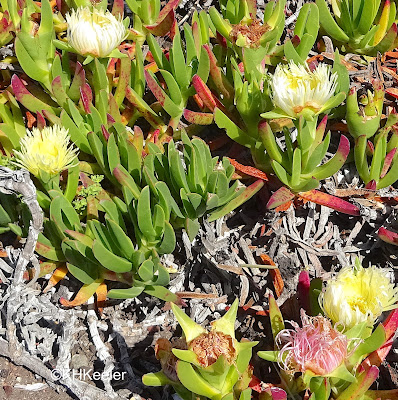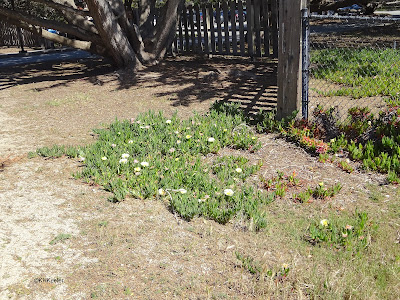Visiting coastal California, you can't miss iceplant (Carprobrotus edulis). It grows in big patchs of pointy green fingers, covering the ground in a monoculture. Probably every visitor and resident in California gets to know it. In 1970, I was a new graduate student taking a Genetic Ecology course at the University of California, Berkeley, from Herbert Baker. He assigned a research paper about a plant. I had no idea what I was doing. I saw iceplant and chose that for my project.
 |
highway iceplant, Carprobrotus edulis
|
So I go way back with iceplant. Iceplant is from South Africa. It was brought to California a hundred years ago and widely planted to stop erosion. It did that pretty well, and was an easy, low maintenance plant, so roads departments and parks, and people generally, planted it all over the place. In 1970 it was very widespread and people were just starting to wonder if that was good thing.
 |
| Iceplant on the Berkely campus 1970 |
Since then, it has become obvious that iceplant is invasive and that it crowds out native species. There is so much of it and it is so entrenched that reducing is a long slow process. The Pacific Grove Museum of Natural History has a flier explaining why not to plant iceplant. Reasons include: It expands rapidly. It takes up and stores water, keeping it from other plants. The big old clones accumulate organic matter that allow other invasive species, which would not survive on sand, to grow and spread. Native animals don't eat it. Its stablization of dunes changes the coastal dynamics to which the natives are adapted.
All the yellow flowers of this lovely coast scene are iceplant:
 |
|
So who is this invader?
Iceplant a member of the Aizoaceae, a plant family with most of its members in South Africa, a few scattered along the coasts of the Southern Hemisphere. It is succulent; the thick leaves are very water-retentive. The leaves are three-sided, 4-5 inches long, spear-like, and rough (serrate) along the ridge of the leaf. It has round, many-petaled flowers in yellow, white, pink and hot magenta. It was flowering in April, and visited by numerous bees.
 |
| flowers of highway iceplant, Carpobrotus edulis |
It spreads when the stems with their thick succulent leaves expand, forming big clones. Shoots easily root, so broken pieces colonize new areas. Old plants grow back over old stems, making a deep pile of old dry iceplant leaves. Native plants don't survive in this odd environment and exotics (the wood sorrel,
Oxalis, in the photo below) invade.
 |
| Leaves of highway iceplant, Carpobrotus edulis |
It also spreads by seed. The fruits are edible. I remember the ripe fruits as tasting pretty good. The common names it brought from South Africa are fig-marigold and hottentot-fig. The round fruits resemble figs; they contain lots of tiny seeds in a heavy, sweet, dark "jelly." I collected the fruits to plant out seeds and look at seedlings. Getting individual seeds out of that "jelly" left me a sticky mess. The fruits are attractive to and eaten by animals, from rabbits to deer, and the seeds germinate better having passed through the animals. I didn't know that when I pulled the seeds out of the fruits; very few of my seeds germinated.
The scientific name reiterates that.
Karpos is fruit, in Greek,
brotos means edible. The species epithet,
edulis, also means edible.
It is tolerant of dry conditions and moderate trampling:
There is too much of it and California is trying to reclaim its coast for native plants.
Fig-marigold and hottentot-fig make some sense as a name. But why is it called iceplant? Well, fifty or so years ago, there were only a couple of plants in the family Aizoaceae anywhere in California (today more have been imported). The Aizoaceaea were recognizeable; succulents with finger-like leaves and round, many-petaled flowers. One that was planted early in central and southern California,
Mesembryanthemum crystallinum, had all those characteristics and large glistening bladder cells or water vesicles that looked bits of ice on the leaves. It was sensible to call
M. crystallinum iceplant. When
Carprobrotus edulis was introduced, even though it didn't have the white bladder cells, people recognized the similarity and called it iceplant too. (See photo from a plant seller, showing the bladder cells well
link go to the photo with the flower). The name stuck. Highway iceplant, the California common name for Carpobrotus edulis, is apt because it was so widely planted along highway margins.
The name Carpobrotus means edible fruit (karpos Greek for fruit and brotus meaning edible). The species epithet, edulis, means edible also (in Latin).
 |
| highway iceplant, Carpobrotus edulis |
Highway iceplant is a pretty plant and might have been nice as an accent in a rock garden. But having been planted on highways and dunes throughout California, it turned out that despite looking like a well-mannered succulent, it has characteristics--easy dispersal, drought-tolerance, competing well against other plants--that make a highly successful invader. As the Pacific Grove flier urges, don't help it spread.
Comments and corrections welcome.
References
Cal-IPC Carpobrotus edulis link (Accessed 4/26/22)
d'Antonio, C. M. 1990. Seed production and dispersal in the non-native, invasive succulent Carpobrotus edulis (Aizoaceae) in coastal strand communities of central California. Journal of Applied Ecology. 27: 693-702.
Stearns, W. T. 1996. Dictionary of Plant Names for Gardeners. Cassell Publishers. London.







Here in Portugal it was introduced to "hold the dunes", but native species like marram grass, with its meter long roots, serve that purpose a lot better. Once again this myth that tells us that "this exotic invasive plant has to be introduced because there's no native species to substitute it".
ReplyDeleteNuno Gomes Lopes here.
Delete